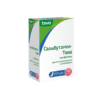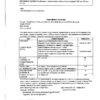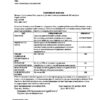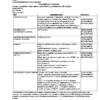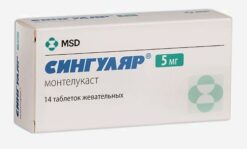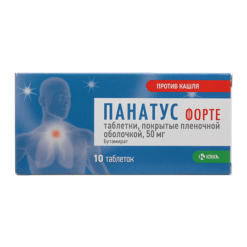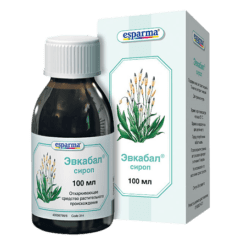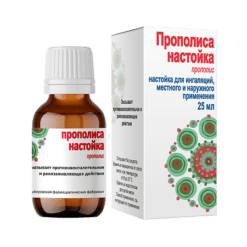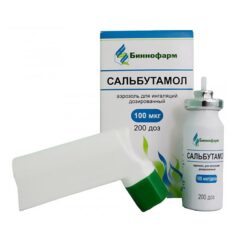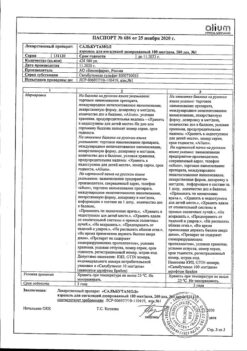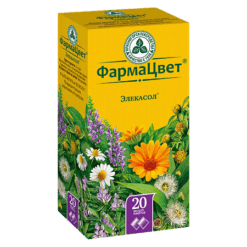No products in the cart.
Salbutamol-Teva, aerosol 100 mcg/dose 200 doses
€4.94 €4.39
Out of stock
(E-mail when Stock is available)
Description
Pharmacotherapeutic group: bronchodilator – beta2-adrenomimetic selective
ATX code: R03AC02
Pharmacological properties
Pharmacodynamics. Salbutamol is a beta2-adrenergic receptor stimulator that acts on the smooth muscles of the airways, causing them to relax and preventing bronchospasm. Reduces resistance in the airways, increases the vital capacity of the lungs. Prevents release of histamine, leukotrienes, prostaglandin D2 and other biologically active substances from mast cells. In recommended therapeutic doses, it does not adversely affect the cardiovascular system (CVS) and does not cause an increase in blood pressure. To a lesser extent compared to the drugs of this group, it has positive chrono- and inotropic effects. Causes dilation of the coronary arteries. It has a number of metabolic effects: decreases the concentration of potassium ions in plasma, affects glycogenolysis and insulin release, has hyperglycemic (especially in patients with bronchial asthma) and lipolytic effects, increases the risk of acidosis.
Pharmacokinetics. During inhalation, 10-20% of the inhaled dose reaches the small bronchi, the rest is deposited in the upper airways. After inhalation administration, systemic absorption is rapid but low. Maximum concentration of salbutamol in blood plasma is observed after 3 hours. Binding with plasma proteins is 10%. It is subject to presystemic metabolism in the liver and intestinal wall. The elimination half-life (T1/2) is 3-7 hours. It is excreted by the kidneys, mainly unchanged (about 90%) and as inactive phenolsulfate metabolite (about 60%) within 72 hours and with bile. Salbutamol penetrates the blood-brain barrier, creating concentrations equal to about 5% of the blood plasma concentration.
Indications
Indications
Active ingredient
Active ingredient
Composition
Composition
1 dose of inhalation solution contains:
salbutamol sulfate – 124 µg, which corresponds to the content of salbutamol 100 µg.
Excipients:
Hydrofluoroalkane (HFA-134a) – 26.46 mg,
Ethanol – 3.42 mg.
How to take, the dosage
How to take, the dosage
The drug Salbutamol-Teva is intended for inhalation with an inhalation device (see “Instructions for patients to use the inhalation device”).
Adults and children over 2 years
To relieve bronchospasm: 100 mcg (1 inhalation) 1-4 times daily. If necessary, the dose may be increased to 200 mcg (2 inhalations) 1-4 times a day.
For the prevention of bronchospasm: by 100-200 mcg (1-2 inhalations) 15-30 minutes before physical activity or possible exposure to an allergen.
The maximum daily dose should not exceed 800 mcg (8 inhalations) during the day.
There should be at least 4 hours between each dose taken.
Patient Instructions for Use of the Inhaler
If you use the inhaler for the first time, or if you have not used it for some time, you check that it works by pressing the canister valve and letting a dose of medicine into the air.
In steps 3 and 4, take your time. It is important to breathe in as slowly as possible as you release the dose of medicine. Practice in front of a mirror before application. If you notice “steam” coming from the top of the can or from the corners of your mouth, start again with step 2.
Cleaning your inhaler
The inhaler should be cleaned at least once a week. Remove the aluminum canister from the inhaler. Gently rinse the inhalation device and the protective cap with warm water. Do not use hot water! Shake the inhalation device and protective cap to remove any residual water and dry them without using heating devices. Do not allow the aluminum canister to come in contact with water!
Interaction
Interaction
Salbutamol is incompatible (pharmacological antagonism) with non-selective beta-adrenoblockers, including propranolol, which should also be considered when using ocular forms of beta-adrenoblockers.
With the hypokalemic effect, salbutamol increases the effect of psychostimulants on the CNS, enhances the cardiotropic effect of thyroid hormones, and increases the likelihood of intoxication with cardiac glycosides.
Theophylline and other xanthines, when used simultaneously with salbutamol, increase the likelihood of tachyarrhythmias; agents for inhaled anesthesia, levodopa – severe ventricular arrhythmias.
Possible increase in heart rate and blood pressure during administration of salbutamol may necessitate dosage adjustment of hypotensive and antianginal drugs.
Monoamine oxidase inhibitors, tricyclic antidepressants, and cardiac glycosides may increase the beta-adrenergic effects of salbutamol and cause a rapid decrease in blood pressure.
In concomitant use with anticholinergic drugs (including inhaled drugs) may contribute to increased intraocular pressure.
Diuretics and glucocorticosteroids (GCS) enhance the hypokalemic effect of salbutamol.
Patients should be instructed to discontinue salbutamol 6 hours before anesthesia with halogen anesthetics.
Special Instructions
Special Instructions
Before using Salbutamol-Teva, it is important to ensure that the patient is using the inhalation device correctly to ensure adequate dosing of the drug.
Patients using Salbutamol-Teva at home should be cautioned that if the effects of the usual dose become less effective or less prolonged, the dose or frequency of administration should not be increased on their own, but should see a physician immediately.
The sudden and progressive worsening of the ability to control the onset of bronchospasm attacks is potentially life-threatening. Consideration should be given to changing the patient’s treatment regimen and/or prescribing additional concomitant therapy.
Patients with long-term use of inhaled Salbutamol-Teva should see their physician regularly.
The possibility of eye contact with the inhalation aerosol should be avoided.
Perhaps caution should be exercised when treating severe bronchial asthma with high doses of salbutamol, because treatment may be accompanied by an increase in serum lactic acid and, in rare cases, lactic acidosis may develop.
Patients with concomitant severe cardiovascular disease, including coronary heart disease, tachyarrhythmias, severe heart failure, and hypertrophic obstructive cardiomyopathy should be advised that if symptoms such as heart pain, palpitations, increased heart rate, and shortness of breath occur or become more frequent, a physician should be seen immediately.
As with other inhalation therapies, paradoxical bronchospasm may occur. In this case, the drug should be discontinued immediately, and an alternative treatment should be prescribed.
Salbutamol should be used with caution in patients with thyrotoxicosis.
The treatment with beta2-adrenomimetics may lead to severe hypokalemia. Particular caution should be exercised in cases of severe bronchial asthma since concomitant treatment with xanthine derivatives, glucocorticosteroids, diuretics, diuretics, as well as hypoxia may contribute to hypokalemia. In such situations, it is recommended to monitor serum potassium concentration.
In concomitant use with cardiac glycosides it should be taken into account that hypokalemia may contribute to intoxication with cardiac glycosides.
In patients with diabetes mellitus when using beta2-adrenomimetics it is necessary to consider the possibility of increased plasma glucose concentrations, as well as, in rare cases, the development of ketoacidosis. Concomitant use of GCS may aggravate this condition. Regular monitoring of blood glucose concentration and dosage adjustment of hypoglycemic agents are necessary to prevent decompensation of diabetes mellitus.
The aluminum can of Salbutamol-Teva must not be pierced, disassembled, or heated, even if it is empty.
Influence on the ability to drive vehicles, machinery
. Due to possible development of dizziness during treatment with Salbutamol-Teva it is necessary to be careful when driving vehicles and engaging in potentially dangerous activities requiring increased concentration and quick psychomotor reactions.
Synopsis
Synopsis
Contraindications
Contraindications
Hypersensitivity to salbutamol and other components of the drug; children under 2 years of age.
With caution
Tachyarrhythmia; coronary heart disease; myocarditis; heart defects; aortic stenosis; hypertrophic obstructive cardiomyopathy; severe chronic heart failure; arterial hypertension; thyrotoxicosis; pheochromocytoma; concomitant use with cardiac glycosides; decompensated diabetes mellitus; pregnancy; breastfeeding period.
Side effects
Side effects
The incidence of side effects is classified according to the recommendations of the World Health Organization: very common – at least 10%; common – at least 1%, but less than 10%; infrequent – at least 0.1%, but less than 1%; rare – at least 0.01%, but less than 0.1%; very rare (including isolated cases) – less than 0.01%; frequency is unknown – there are not enough data to estimate the frequency of occurrence in the population.
Cardiovascular system: frequent – tachycardia; infrequent – palpitations; very rare – arrhythmias (including atrial fibrillation, supraventricular tachycardia and extrasystoles); frequency unknown – myocardial ischemia (cause unknown).
From the central nervous system (CNS):often – headache, generalized tremor, anxiety; rarely – sleep disorders and hallucinations (especially in children), hyperactivity (in children); very rarely – dizziness, tension.
In the respiratory system, thoracic and mediastinal organs: infrequently – irritation of the pharyngeal mucosa; very rarely – paradoxical bronchospasm.
From the digestive system: infrequent – irritation of the mucous membrane of the oral cavity and pharynx, dryness of the mucous membrane of the oral cavity and pharynx; very rare – nausea, vomiting.
Skin disorders: very rarely – skin itching, dermatitis.
Musculoskeletal system: frequent – myalgia; very rare – minor tremor (in particular hands).
Allergic reactions: very rarely – hypersensitivity reactions (urticaria, Quincke’s edema, arterial hypotension and collapse).
Others:seldom – hypokalemia, hyperglycemia, lactoacidosis
Overdose
Overdose
Symptoms: nausea, vomiting, hyperexcitability, tachycardia, ventricular flutter, decreased blood pressure, hypoxemia, lactoacidosis, hypokalemia, hyperglycemia, muscle tremor, headache, hallucinations.
Treatment: symptomatic; in tachycardia, cardioselective beta-adrenoblockers are administered. Administration of selective beta1-adrenoblockers in patients with bronchial asthma requires extreme caution because of the high risk of bronchospasm.
Pregnancy use
Pregnancy use
Similarities
Similarities
Additional information
| Shelf life | 3 years. Do not use after the expiration date. |
|---|---|
| Conditions of storage | At a temperature not exceeding 25°C, protect from direct sunlight. Do not freeze. Keep out of reach of children. |
| Manufacturer | Norton (Waterford) Limited, Ireland |
| Medication form | metered aerosol for inhalation |
| Brand | Norton (Waterford) Limited |
Related products
Buy Salbutamol-Teva, aerosol 100 mcg/dose 200 doses with delivery to USA, UK, Europe and over 120 other countries.





